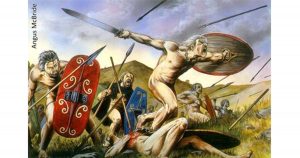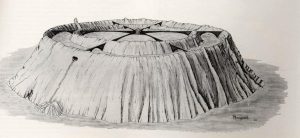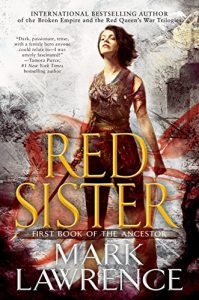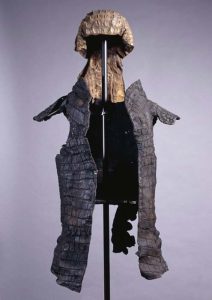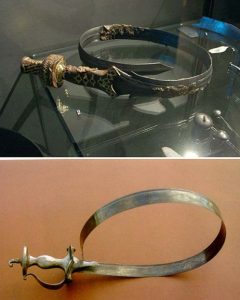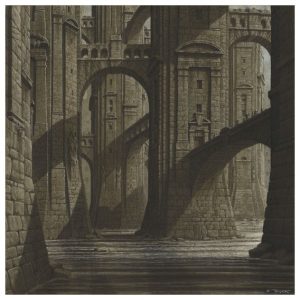Over on the Shadow World thread at FM Forums I posted up dozens of files on Diety specific spell lists and new SW religions plus an “Invocation” chart for any player that wants to call to their God for help. I’ve bundled all of that into 2 files below and you can read my blog on SW Religions HERE.
I’m curious. Magic item ubiquity in your Rolemaster or Shadow World game.
I’ve followed several forum threads on the “commonness” of magic and magic items and thought I would ask people what they would consider as an average magic item kit for various professions at 5th lvl.
In general, in your game, what would the following have for magic or bonus items (but be specific on item and bonus, power or ability):
5th lvl Fighter
5th lvl Magician
I’m on the rarity end of the spectrum, plus I use a lot of single use magic items and roll for breakage on items. If I were starting players at 5th lvl I would do something like this:
Fighter. +10 non magic superior armor. +15 weapon. 2-5 single charge items (a mixture of protection or healing). maybe a Daily II item (offensive spell) if the group is small or it needs some skill diversity.
Magician: x2 PP multiplier. 2-4 Daily I-IV items (around 5th level spells for protection and attack). 2 Charged Items. 50 pp’s in storage (essence crystal)
My spell users have far fewer spells than traditional RM, so I add basic capabilities through daily items and charges. I generally provide a good level of PP’s, but I use unpredictable Essaence effects (in our encounter tables) so casters face gain/loss of PP’s or increase in casting failure.
Rolemaster Combat Maneuvers: Fighting Naked.
So RM & RMU has introduced a variety of combat maneuvers and combat penalties: blind fighting, close quarters, protect, mounted combat etc. How about a new one: Naked Fighting.
Sure you might not have the advantage of armor, but you would, or could, have the advantage of “shock & awe”. Maybe an extra “stress” or “depression” critical is dealt when the naked fighter crits?
How about a whole cadre or group of warriors that went into battle naked?
So, I did have one naked NPC attack the group once years ago. But I like the theatrics of a group of naked beserkers rushing the group. Thoughts?
btw: look who did that picture!!!
Shadow World Spin Cycle: Court of Ardor pt. 3
I started SW Spin Cycle almost a year ago and wanted to get back to it again. Today I want to discuss one of the cooler and larger fortresses found in the Court of Ardor: Mirisgroth. I remember when I first saw the drawing, the size and scope of the MERP/ICE products really struck home. This was something more than simple dungeon layouts on graph paper…it felt MONUMENTAL. Not only is Mirisgroth just cool (supposedly Fenlon used a similar fortress in one of his projects later?) but it can substitute for one of the Secrets of the Jerak Ahrenrath: the Ahrenraax in Thuul. I’ll admit that it might not be as good a match as some of the other Ardor fortresses to Shadow World, but to me it just feels right.
Here are the descriptions:
Mirisgroth from Court of Ardor:
Mirisgroth (S: “Mine of Jewels”)
A vast mining complex, Mirisgroth is basically a natural formation , a volcano which collapsed in upon itself not once. but twice in the distant past. Now dormant. it is two concentric rings of steep, jagged volcanic stone in the center of which, built upon a rocky spur, is a small hexagonal hold. Radiating out from the castle are six iron bridges which connect to the inner ring, and resume to join the inner ring to the outer. The rings of slag proper are laced with interconnecting tunnels and chambers, and deep mine shafts. For details of this area, see the plan diagram. The outer circle holds a garrison Of 1000 Orc miner/guards. In the inner circle resides a mixed population of 500 Human and Dwarven miner/guards. The entire facility is administered and supervised by Cambragol, ‘The Monk”, or Persuvious in his absence.
Ahrenraax from Powers of Light & Darkness:
The citadel of Ahrenraax (Ir.: “Secret Claw”) was located in the cool waters southwest of Emer. Stewardship of this volcanic island fortress was given to the Lord Ordainer Morloch (once known as Shúraax the Fire Claw, bodyguard of Kadæna).
In but a few decades Morloch had built Ahrenraax into an unsubtle palace of crude splendor. He marshaled forces and subjugated the northeast regions of Thuul by TEI 1204.
I think very little needs to be changed to utilize this fortress in your Shadow World campaign—assuming your players would even want to mess with the Secret Circle! I’ve utilized Morloch in my “Priest-King” module so I had some interest in fleshing this out on the off-chance my players actually wanted to infiltrate the fortress. A few items to consider:
- Althan Teleport System. Some of the Secrets built on Althan installations were connected via a Portal system (Bakuul Portals) that might be a convenient way to get the players into the fortress.
- The Fortress is overseen by Morloch—a powerful Ordainer Demon who was once bodyguard to Kaedena! As powerful as he is, he might also be a better arch-villian for the group than one of the members of the Circle. Morloch’s power is greatly reduced as his empire around Thuul has been absorbed by the encroaching Alliance.
- Crystal Shard. Each Secret has a splinter of the Crystal. Looking at the layout, this could be placed in # 36 in Court of Ardor:
Shrine. There is a 8′ long slab of granite set on a pedestal on a small altar at the far end of the room,. flanked by ever-burning fire-pits. The granite slab has a shallow trough running along the perimeter, and a slot at the foot of it for runoff to flow into a golden cup which sits just below. There are many dark stains on the slab. There are also four iron manacles, set into stone to hold wrists and ankles, On a narrow pedestal to one side lies a long dagger made of red laen. It, too, has stains on it . although laen does not usually stain. This is Cambragol’s altar to Morgoth, and he comes here secretly at times, bearing a sacrifice: usually a young Elven man or woman. Here he enacts a grisly ritual, and as a result is able to commune as a Cleric for the night. He can do this but once per month.
That sounds like it would work!
- This is a large fortress with a huge population of Lugroki (outer ring) and Thesian soldiers (inner ring). Like any large facility, it requires a constant stream of supplies and its mining operations continually export mined valuables. There are a lot of moving parts that should make it easy for the PC’s to gain access (if they disguise themselves) to the fortress proper but exceedingly more difficult to enter the inner parts. (I think of these fortresses as a James Bond villain fortress)
Overall, I think Mirisgroth works well here and with other Secrets described in Emer Boxed Set and Emer III, that makes at least 4 Secrets that players can explore!
Random Reading: Red Sister
This is not a book review…I recently started reading a great book, Red Sister by Mark Lawrence. Mark is the author of 2 other series: The Broken Empire and the Red Queens War. Like his other series, Red Sister takes place in a fantasy world with a lost high tech heritage—a bit like Shadow World!
When I’m reading a new fantasy series with a magic system I try to figure out if the portrayed system can be based on Spell Law/Rolemaster or if there are any cool spell ideas I can incorporate into Project BASiL. Having read quite a bit, I can say that many of favorite spells and lists were inspired by fantasy fiction.
Red Sister offers up several ideas that feed into recent discussion and posts here on Rolemasterblog. First is the idea that setting drives the rules and second, that Channeling could be rolled into Esssence (or eliminate realms entirely).
Of particular note in the book (no spoilers)
Races. The population was descended from 4 races. One that had great size and strength; one that had incredible speed, one that could tap into lesser magics and one that could tap greater magics. While this is a common trope, sometimes I do miss more differentiation between the races in RM and SW. Barring some stat bonuses (whose impact are minimized at higher levels) most races are defined by physical characterization than special abilities or extremes of nature.
Religion. The story focuses on a convent, one that trains young women in the esoteric arts. Holy Sisters, the most common are focused on maintaining the faith. Grey Sisters focus on stealth and poisons and have a talent for “Shadow Work” (mentalism?). Mystic Sisters manipulate threads (magic) and Red Sisters excel on armed and unarmed combat (warrior monks). What I like, and what’s been discussed here on this blog, is the idea of “agnostic magic”—magic defined by aspect, focus or effect rather than Essence, Mentalism and Channeling. Religions and churches train in magic and have access to this special knowledge, but magic use isn’t tied to or dependent on a diety.
So far it’s been a good read. If you like “Monk” stories I would also recommend Witches Blood.
Any books you’ve read that could fit the Rolemaster/Spell Law system?
Shadow World Flavor: Cool suits of Armor.
Just a few days ago I posted up some of the unique armors that I had developed for Shadow World cultures and groups. This included a laminate process, slate armor and various hide armors using Wyvern and Quarnak skins. You can download the file HERE (you need an RM Forum user account)
So it was interesting to see this short article on historical armors HERE. I thought the crocodile armor (pic above) was really neat!
Shadow World Weapon: the Urumi
I was doing some research and looking for ideas for a interesting cultural weapon and came across the Urumi. Functionally it’s a steel whip–deadly to opponents and deadly to use for the wielder!
Using RM weapon tables, the whip table makes the most sense with only slash criticals. To differentiate even more, I can devise weapon specific performance using our “Weapon Modifier Chart“.
Of note:
urumi-wielders learn to follow and control the momentum of the blade with each swing, thus techniques include spins and agile maneuvres.[2] These long-reaching spins make the weapon particularly well-suited to fighting against multiple opponents
The benefit of our optional rules for weapon stats is that it allows for customization and differentiation beyond their efficacy against AT’s and their hit & crit thresholds on the attack chart. RMU established fixed penalties for several combat maneuvers (reverse strike, dual attack, protect etc) when it should be the particular weapon that decides that penalty. Shouldn’t unarmed combat have a lower multiple attack penalty than a warhammer?
Anyway, the Urumi would have a low multiple attack/opponent, flank and rear attack penalty but have a VERY HIGH fumble range and no real ability to parry.
Also:
When not in use, the urumi is worn coiled around the waist like a belt
I have a few cultures or groups where this would be a great weapon: the Daughters of Inis and a special group utilized by the Alliance in Agyra.
I’m sure if I looked the Urumi is probably already included in Combat Companion or some other past publication, but I don’t have those so it struck me as very cool!
Shadow World Speculation: What is the Mazatlak Pillar City?
For those that have perused the extensive Shadow World timeline in the Master Atlas or Part IV: Lands will have seen a few references to the Mazatlak Pillar City. Call me intrigued! There are four references in the Master Atlas (I’m using 3rd Edition):
p.31
- Mazzara Delta: [Cool Temperate/Seasonal] Y’nar (Mixed economies/Monarchy/TL: ) A vast delta/archipelago; this fragmented land and the shores to north and south are controlled by a Y’nari kingdom. At the head of this delta is the capital: Mazatlak Pillar City.
Gendael: A trading center where furs, ores, fish, meat and other staples are exchanged for exotic spices and other items from more temperate lands. The road to Mazatlak is heavily travelled.
Mazatlak Pillar City: A regional trade center and capital of the Mazzara Delta kingdom.
p.184 (Timeline 6053 TE)
Mulira: Mazatlak Pillar City shakes but the ancient stone pedestals stand.
So, what the heck is a “Pillar City”? That’s been churning around in my hind brain for years; trying to imagine what that would look like and how to design the city for a possible module. The few clues we can glean is that it’s a city, it has pillars which can shake, it’s located on a river delta:
Definition of delta: a piece of land shaped like a triangle that is formed when a river splits into smaller rivers before it flows into an ocean
The impression is lowlands, prone to seasonal flooding that require houses built on stilts like many third world areas. Like this:
But Mazatlak isn’t a “stilt village”, it’s a “Pillar City” with stone pedestals. That makes me think of this:
This is the famed Basilica Cistern in Constantinople. So this could be a good model of Mazatlak: a normal city with a vast foundation made up of pillars and columns. This feels right and creates a great opportunity for a dual world: the normal city above and this surreal “underneath” where trade, commerce and skullduggery could occur! This also reminds me of Chicago where they built a new street level above the first floor of the buildings and created a below ground world that mirrors the city above.
I was good with that image until I thought of something more fantastic. In my interview with Terry he mentioned his building design was more grounded in reality while Pete Fenlon designed more over the top structures. Is Mazatlak interesting enough as just a city built on a foundation of pillars? Is that too mundane and realistic? Then I imagined the city as large platforms on immense stone pillars. Sort of a Cloud City of Bespin, but with a thicker more substantial pillar as a base. The platforms would be connected via bridges and the heights of each platform would indicate status and prestige.
So while I’m finishing up Nontataku, thoughts of Mazatlak kept buzzing around in my head. I wish I were an artist or illustrator and could explore different concepts through drawing. Then, the other day I was reading RPG Bloggers and this came up, an illustration by Gerard Trignac:
I thought, “The Pillars ARE the City!). For Mazatlak I see the pillars being round, and much larger than this picture.
One final idea I had was that the Pillar City was actually much older, originally a Hirazi city—soaring columns with eyries on the top that was later populated by Y’nar settlers. Obviously I have several competing thoughts on this “Pillar City” that Terry hints at. Anyone have thoughts, ideas or suggestions?
Rolemaster: Outside Looking In.
I’ve been reading quite a few RPG blogs lately, and as you might imagine most of them discuss DnD or one of it’s near variants. Some of it is nostalgia (OSR), part curiosity, and general interest in other viewpoints and experiences. One thing I notice over and over–most of these other blogs and forums don’t spend too much time on rule litigation/arbitration. Most blog posts are:
- Product reviews or retrospectives
- In game experiences
- General advice on creating content or running games.
That made me wonder what non-RM rpg players see when they encounter online RM content. First, if you google “rolemaster, blog” you won’t get that many results. Some of it is older forum discussion on “chartmaster”, “rulesmaster” or the complexity of playing. That’s probably not best foot foward. So how about the people that check out the RM Forums? What do they see or what impression do they get? If they aren’t a member they won’t see the RMU development forums (that may not be a bad thing–those discussions really get in the weeds). If you are active on the RM Forums, take a step back and look at it through the lense of a new user.
One of the most active thread topics of course is “Rolemaster”. What are the current topics? “Withdrawing from Melee”, “How to teleport into a moving target”, “how to handle Perception/Stalking”, “monster orientation roles”. These threads and many, many more are adjudication topics–“How do I handle this or interpret the ruleset”?
I’ve made the analogy before comparing Rolemaster to DOS and other game systems to MAC OS. DOS users love to tinker and program while MAC users just want a packaged user experience. While I consider the “rule programming” of RM a plus, I often wonder if it has been at the cost of user experiences (game content). Obviously Terry can only write so much, so fast. MERP is in permanent stasis, Cyradon and Echoes of Heaven are…(I have no idea really)? When people do wax nostalgic about RM it’s usually about the old MERP modules: artwork, maps etc and of course the cool critical tables. How do you create more content? Does opening up to third parties help? Is there even a large enough user base?
When I read about cool new content and modules in other RPG blogs, I sometimes feel like an outsider. What do other players see when they look at RM now?
Channeling, it’s not just for Gods anymore?
Why do I keep coming back to Channeling? Tackling Spell Law deconstruction and rewrite forced me to look at all the underlying assumptions around the magic system—not just RM but other games as well. I think Essence (generic magic) is easy: as long as you allow for the phenomena, then simple rules allow for casting spells. Mentalism is not much different than Essence and often conflated as Psionics. Channeling is a whole other can of worms: God given magic REALLY needs to work in a completely different way. We’ve discussed Channeling in depth in several blogs HERE, HERE and HERE.
How might Channeling be different than the other two magic Realms?
Spell Acquisition. Unlike Essence or Mentalism, a PC can’t just go to a library, secure a scroll, learn a spell list and then cast a channeling spell. A “God” must give at least tacit approval for someone to cast a channeling spell. Additionally, you could argue that no learning is really needed—spells could be directly granted by the Diety. This changes the standard process of spell acquisition.
Spell Effects. Common sense would dictate that a caster might not be able to provide magical buffs, benefits or spell effects to targets of an opposing Diety. Unlike Essence which is agnostic, Channeling is driven by an ethos, aspect or belief system. You shouldn’t be able to heal a follower of a mortal foe of your God…right? So the whole group dynamic might be complicated when the Cleric is the primary “buffer” and healer for the group but the other members of the group worship different gods.
Force Majeure. RM Channeling description suggests that PP’s are funneled to the caster and in my BASiL project the spell itself is funneled to the caster (ie like a software download). Either way, the Diety is providing, approving or allowing part of the casting formula. That requires SOMETHING in return on the part of the caster: certain behavior, loyalty, tribute, sacrifice, tithing etc.
Certainly much of this relies on the setting. These may seem like niggling over fine points; and you can certainly hand-wave away any needed explanation—it is religion after all. But RM and RM users take a certain pride in quantifying effects into game mechanics: detailed herbs and spells for healing; complicated Alchemy rules for magic item creation; math driven charts for modelling weapons and armor effects. If Channeling raises some broader questions about its use, than why not establish this in the game rules?
Personally, I’ve come down to two broad options:
Option 1. Disconnect the Channeling mechanism between a caster and a Diety. As Peter argued, Channeling could just be rolled into Essence as “general magic”. That makes sense. Just disconnecting Dieties from spell casting mechanics eliminates all of the awkward questions that Channeling raise in the above examples. If you were you to do that, what then would be the purpose of Dieties?
- They can still bestow “beneficence” in answer to prayers for held or assistance.
- Lead, create and direct religious organizations.
- Control the dissemination of hidden knowledge (spell lists and certain skills).
- Interfere in the mortal world
Under this option, Gods are still supreme entities, still have the same powers, play the same role in the world but just don’t act as a conduit for Channeling spells.
Option 2. Go “all in”. Further develop Channeling as a relationship between a powerful being and a follower. If we accept that channeling magic is controlled, allowed, or provided by a Diety than how should that work? More importantly, what prohibits anyone from being having followers and Channeling spells/power to them? I’ve touched upon this with my BASiL Channeling project—spells that only work with designated targets: loyal followers, henchmen, oathbound etc.
The idea goes back to the issues explored earlier—that a Cleric can provide powerful benefits, but only to followers of the same Diety. For Holy Warriors, it becomes even more specific—benefits are only bestowed upon the group, militia or organization of the Holy Warrior. (ie High Templars cast spells to the benefit of his soldiers and/or followers).
The Gods of Shadow World aren’t really gods—just very powerful entities from another dimension. How do they parse out spells/powers? Do they control the entry point of Essaence into Kulthea? Did they devise spells and teach them to their followers? If they are just powerful beings, then can any powerful PC or NPC also grant similar spell ability to their followers? Popular fiction is replete with “Lords” or “Archmages” bestowing their hirelings and henchmen with special abilities—isn’t this Channeling? How about the Dragonlords? Are they powerful enough to act as Minor Gods? Can Minor Gods in Kulthea also provide Channeling to their followers?
At what point can a person bestow spells or power to another? RM already establishes a base mechanism for transferring PP’s or spells with the Channeling SKILL. I would take it a step further: a formalized process of creating a relationship between “god/lord/being” and “followers”. I played around with an initial spell list concept I uploaded HERE. (RM Forum account needed to access the list). Conceptually, the mechanics of a Channeling process should include:
- Bond, link or loyalty or obligations between a god & a follower.
- Mutual benefits to both parties. (follower gets spells/benefits, God gets…?)
- A substantial downside if the bond is broken, destroyed or a party is killed.
My list needs a lot more work (more specifics on penalties and drains–comments welcome) and is just one possibility of many. (Perhaps the Lords of Orhan use a similar but different spell list). But the framework is there and I like the possibilities for a number of reasons:
- It allows a PC/NPC to grow in power outside of the normal experience/level/skill paradigm.
- Establishes a known process for Gods to be created/and or a player to ascend to a demi or minor god.
- Creates a mechanism for a powerful lord/being/god to influence a local event or encounter.
- Provides benefits for a player to pledge to a lord/God.
- Balances risk and reward for such a relationship. (need some more work on this)
- Acts as an adventure hook.
Is the list too powerful? It certainly wouldn’t be readily available, but let’s review the cost/benefit analysis to a PC using the list:
- A follower would have to forgo any other Channeling relationship. (no other god)
- The player would need to offer a real benefit to a follower to justify their fealty.
- Followers would be a liability. An adversary would target a player’s followers knowing that would weaken or harm the player.
- Each follower will require a resource drain on the player.
- The benefit would be a growing pool of devoted followers which the player can enact agency through and receive some benefit (HP, PP, stat points?—needs some more thought)
Ultimately Options 1 and 2 aren’t mutually exclusive. I can still disconnect Channeling realm from Dieties and still have the Channeling list and mechanics. Anyway, this went from a thought experiment: “how should Channeling Realm work” to the start of an interesting game mechanic for my SW campaign. Channeling isn’t just for Gods anymore!



